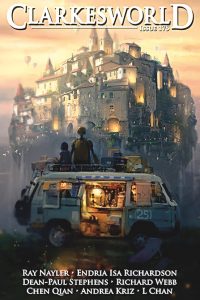Ian Mond Reviews Dark Constellations by Pola Oloixarac
 Dark Constellations, Pola Oloixarac (Soho Press 978-1-61695-923-4, $26.00, 216pp, hc) April 2019.
Dark Constellations, Pola Oloixarac (Soho Press 978-1-61695-923-4, $26.00, 216pp, hc) April 2019.
Pola Oloixarac’s second novel, Dark Constellation, translated by Roy Kesey, spans a one-hundred-forty-year period, beginning in 1882. Plant biologist Niklas Bruun is the youngest member of an expedition charting the archipelago of Juba and specifically the volcanic crater of Famara. There he discovers a plant, Crissia pallida, whose properties will, enigmatically, “remain all but unknown until the beginning of the twenty-first century.” Leap forward a century to 1981, where Sonia Liberman is in the process of conceiving hacker extraordinaire Cassio Liberman Brandao da Silva:
One can see Sonia Liberman, the blonde daughter of a prosperous Argentinian real estate agent, in a supine position, wearing a very short flowery dress, receiving violent bursts of seminal discharge.
Like all infamous hackers, Cassio makes his mark at a young age, almost arrested as a 12-year-old for breaching the electronic defences of a Boston bank. However, it’s not until Cassio has a long and boozy conversation with legendary hacker Max Lambard that he finds a purpose, travelling to Patagonia where he joins Lambard at the Balserio Institute. The narrative then jumps a further two decades, circa 2024, where we’re introduced to Piera, a biologist who has been hired by Max to join Stromatoliton, a research group that’s spun out of work conducted at Balserio. Why Stromatoliton would need a biologist isn’t immediately apparent to Piera until she meets Cassio and he explains the horrifying breadth of the project, the ability to use DNA to monitor in real-time the movement of every individual on the planet.
Because I don’t have my finger on the New Scientist pulse, I thought the idea of monitoring people through their genetics was an inventive, part. Wasn’t I surprised then when, in late February, the New York Times published an article about how China had started using DNA to keep track of the Uighur, an oppressed, predominantly Muslim minority group who live in the north-west of the country. Dark Constellations shows us how this might be applied on a worldwide scale, the roll-out of cameras installed with the functionality to sniff out DNA that is then, almost instantaneously, compared against the information stored in a massive database of our genetic material, sorted and sifted by powerful quantum computers. Out of all the books I’ve read recently about mass surveillance, whether it’s Gnomon by Nick Harkaway or Infinite Detail Tim Maughan, I found Oloixarac’s version to be the most chilling, mostly because it adds an extra layer of ick-factor to something that’s already extremely intrusive, using the ancient strands of our biology against us.
While Dark Constellations might have brought into question my cozy views on mass surveillance, I got a kick out of Oloixarac’s portrayal of the hacker movement in the ’80s and ’90s. I wasn’t involved in the scene back then; my biggest claim to fame was that I went to school with Nahshon Even-Chaim, AKA Phoenix (look him up on Google), but it’s a sub-culture I’ve always found fascinating. Cassio is the quintessential hacker, almost the archetype: brilliant, socially awkward, who struggles with women (though he’s not a virgin), and is obsessed with Blade Runner. Or, to put it another way, he’s a young man desperate to engage with the world, to make his mark through the medium of code and algorithm. When he designs a “constellation of autonomous agents”, encrypted algorithms hiding in plain sight on servers across the world, Oloixarac’s dispassionate style of writing takes on a poetic flair:
The algorithms were like golems, their bodies hidden in the high grass of data, awaiting the key that would turn them into something monstrous, potentially beyond control.
You might be wondering what Niklas Bruun and the plant he discovers on an island near South Sudan have to do with hackers, DNA and mass surveillance. I’m still none the wiser. We’re told early on that Brunn’s brain forms part of Stromatolitons’ Humans and Hybrids collection and that the phenomena Brunn recorded “incorporated a matrix of forms” that “would become one of the cornerstones of the Project.” Whatever these phenomena or matrix of forms are was never clear to me; I failed to join the dots. Not that it ultimately matters. These 19th-century interludes that thread through the novel, a fever dream of sex and hallucinogenics and weird experiments, contrast beautifully against the straight-laced prose of Cassio and Piera’s story. While I may not have appreciated everything Oloixarac intended with Dark Constellations, as a history of a future that has yet to come to pass I found it equal parts intriguing and terrifying.
This review and more like it in the April 2019 issue of Locus.
 While you are here, please take a moment to support Locus with a one-time or recurring donation. We rely on reader donations to keep the magazine and site going, and would like to keep the site paywall free, but WE NEED YOUR FINANCIAL SUPPORT to continue quality coverage of the science fiction and fantasy field.
While you are here, please take a moment to support Locus with a one-time or recurring donation. We rely on reader donations to keep the magazine and site going, and would like to keep the site paywall free, but WE NEED YOUR FINANCIAL SUPPORT to continue quality coverage of the science fiction and fantasy field.








